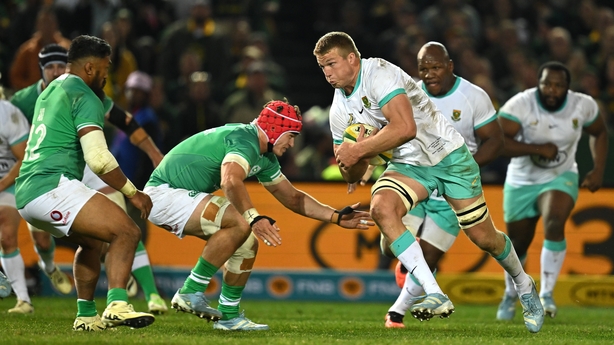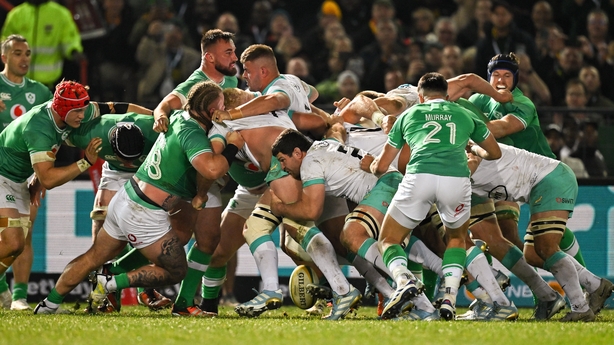Given Ireland's history with Tony Brown, the first half of the 27-20 defeat to South Africa last Saturday shouldn't have come as much of a shock.
The New Zealander had been attack coach to Japan when they beat Ireland at the 2019 Rugby World Cup, as the Brave Blossoms produced a stunning attacking display to pull off one of the biggest shocks in the history of the tournament.
Now working under Rassie Erasmus at the Springboks, Brown is looking to expand the gameplan of the world champions which, if successful, could spell trouble for a lot of countries in four years' time.
It's very early days in this World Cup cycle, but the first signs of a more open and expansive Springbok attack were evident in Saturday's first Test.
All week, Ireland's players and coaches insisted they had been doing their homework on what to expect from the South African attack, based on the Boks' previous game against Wales last month. However, Andy Farrell was left frustrated by his side's passive defending in the first half, which gave up a try inside three minutes to Kurt-Lee Arendse.
And Brown says his team's wide-wide strategy had been devised with Ireland's commitment to disrupting the ruck in mind.
"We always plan the attack around the teams that we're playing, so we've put a lot of time and effort into analysing Ireland around how they defend, how they attack the breakdown, so we saw a few opportunities," he said this afternoon.
"Ultimately, we always look to plan around the team we're playing."

For such a plan to work, a team has to have the cattle around the pitch to win their own breakdown, particularly in the face of an Irish pack that have established ball-winners like Tadhg Beirne, Caelan Doris, Josh van der Flier and Peter O'Mahony.
Fortunately for South Africa, they have that in abundance, both in terms of their work in open play and at the setpiece.
"Our attack only works if the forwards are good. They need to be able to get gainline for us and carry the ball, pass, clean out. They've got so many demands on them.
"It's been nice to keep challenging them to be able to move the ball and hopefully we're going to continue to get better through the year."
While Ireland only conceded one try in that first half, they were forced to scramble in defence on multiple occasions, and only for an excellent choke tackle by Jack Crowley, Cheslin Kolbe could have been in for a second Boks try after some more fast ball to the wings put Pieter-Steph du Toit into space.
Siya Kolisi also caused Ireland real issues with his carrying, exemplified by how he bounced Robbie Henshaw early in the game (below).

And Brown is excited by what South Africa can do when they get their back row players into possession in the wider channels.
"Obviously, the South African team have some outstanding loose forwards, it's not a new or different tactic, other teams do the same. It's more around getting the best out of the players we have out there.
"Pieter-Steph and Siya have got amazing skillsets. They're big players, pretty dynamic with ball in hand so it's around giving them the license and freedom to do what they do well and the rest of the team complementing that."
South Africa's attack didn't pick apart as many holes in the Irish defence in the second half, with the introduction of Garry Ringrose at half time, as well as some harsh words from Farrell, putting a bit more life in the Irish line.
The Springboks showed they can win more than one way though, and Kolbe's relentless hard work was rewarded when he took advantage of James Lowe's mistake on the touchline to score his team's second try, before the forwards sealed the deal late on with a penalty try as they marched Ireland back over their own line, to take a deserved lead in the series ahead of Saturday's meeting at King's Park in Durban (4pm).

"I don't think I've seen such a dominant scrum ever in the game of rugby then the penalty try. I know that with Japan, it was ball-in and ball-out as quick as you could.
"It's very nice to coach the South African team where the setpiece is quality, they're big men and they dominate the gainline. You can do a lot of good things on the rugby field if you've got speed and momentum.
"It was a really tough Test match, both teams were going pretty hard at the breakdowns and there was a lot of messy rugby. But the things we're trying to do on attack had some really good signs, especially in the first half where we created a lot of momentum and width and the boys were able to apply a lot of pressure and score a pretty good try early on.
"It's going to be fierce again, Ireland have traditionally been strong at the breakdown defensively. From an attacking point of view, we've got to be better.
"Ireland want to slow our ball down and disrupt our attack so we've got to make sure our breakdown is quality and our ball carry is quality," Brown added.


